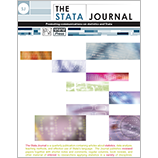Confidence intervals for rank statistics: Somers' D and extensions
Abstract. Somers’ D is an asymmetric measure of association between two
variables, which plays a central role as a parameter behind rank or
nonparametric statistical methods. Given predictor variable X and outcome
variable Y , we may estimate DYX as a measure of the effect of X on Y , or
we may estimate DXY as a performance indicator of X as a predictor of Y. The
somersd package allows the estimation of Somers’ D and
Kendall’s τα with confidence limits as well as
p-values. The Stata 9 version of somersd can estimate extended
versions of Somers’ D not previously available, including the Gini
index, the parameter tested by the sign test, and extensions to left- or
right-censored data. It can also estimate stratified versions of
Somers’ D, restricted to pairs in the same stratum. Therefore, it is
possible to define strata by grouping values of a confounder, or of a
propensity score based on multiple confounders, and to estimate versions of
Somers’ D that measure the association between the outcome and the
predictor, adjusted for the confounders. The Stata 9 version of
somersd uses the Mata language for improved computational efficiency
with large datasets.
View all articles by this author:
Roger Newson
View all articles with these keywords:
somersd, Somers' D, Kendall's τ_a, Harrell's c, ROC area, Gini index, population-attributable risk, rank correlation, rank-sum test, Wilcoxon test, sign test, confidence intervals, nonparametric methods, propensity score
Download citation: BibTeX RIS
Download citation and abstract: BibTeX RIS
|
